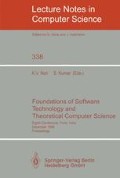Abstract
A counting finite-state automaton is a nondeterministic finite-state automaton which, on an input over its input alphabet, (magically) writes in binary the number of accepting computations on the input. We examine the complexity of computing the counting function of an NFA, and the complexity of recognizing its range as a set of binary strings. We also consider the pumping behavior of counting finite-state automata. The class of functions computed by counting NFA's
-
(1)
includes a class of functions computed by deterministic finite-state transducers;
-
(2)
is contained in the class of functions computed by polynomially time- and linearly space-bounded Turing transducers;
-
(3)
includes a function whose range is the composite numbers.
Preview
Unable to display preview. Download preview PDF.
References
Ginsburg, S. “Examples of abstract machines,” IEEE Trans. on Electronic Computers 11: 2 (1962), 132–135.
Ginsburg, S., and Greibach, S.A. “Abstract families of languages,” Studies in Abstract Families of Languages, pp. 1–32, Memoir No. 87, American Mathematical Society, Providence, R.I., 1969.
Hopcroft, J.E., and Ullman, J.D. “Introduction to automata theory, languages, and computation,” Addison-Wesley, Reading, Mass., 1979.
Salomaa, A., and Soittola, M. “Automata-Theoretic Aspects of Formal Power Series,” Springer-Verlag, Berlin, 1978.
Stearns, R.E., and Hunt, H.B. III. “On the equivalence and containment problems for unambiguous regular expressions, regular grammars, and finite automata,” SIAM J. Comput. 14 (1985), 598–611.
Stockmeyer, L.J., and Meyer, A.R. “Word problems requiring exponential time,” Proc. Fifth Annual ACM Symposium on the Theory of Computing (1973), 1–9.
Stockmeyer, L.J. “The Complexity of Decision Problems in Automata Theory and Logic,” Doctoral Thesis, Dept. of Electrical Engineering, Massachusetts Institute of Technology, Cambridge, Mass., 1974.
Valiant, L.G. “The complexity of computing the permanent,” Theor. Comput. Sci. 8 (1979), 189–201.
Valiant, L.G. “The complexity of enumeration and reliability problems,” SIAM J. Comput. 8: 3 (1979), 410–421.
Author information
Authors and Affiliations
Editor information
Rights and permissions
Copyright information
© 1988 Springer-Verlag Berlin Heidelberg
About this paper
Cite this paper
Rich, C.A., Slutzki, G. (1988). The complexity of a counting finite-state automaton. In: Nori, K.V., Kumar, S. (eds) Foundations of Software Technology and Theoretical Computer Science. FSTTCS 1988. Lecture Notes in Computer Science, vol 338. Springer, Berlin, Heidelberg. https://doi.org/10.1007/3-540-50517-2_83
Download citation
DOI: https://doi.org/10.1007/3-540-50517-2_83
Published:
Publisher Name: Springer, Berlin, Heidelberg
Print ISBN: 978-3-540-50517-4
Online ISBN: 978-3-540-46030-5
eBook Packages: Springer Book Archive

